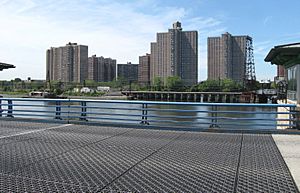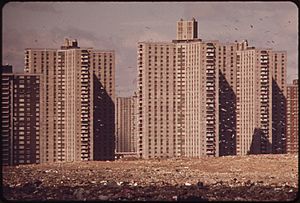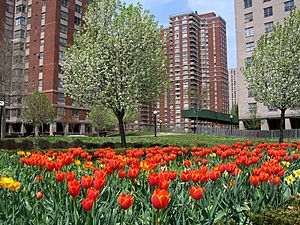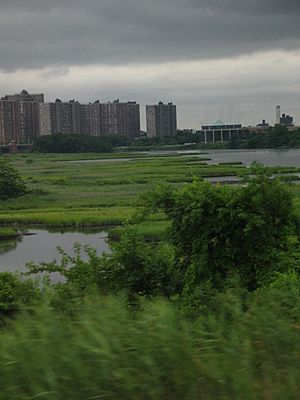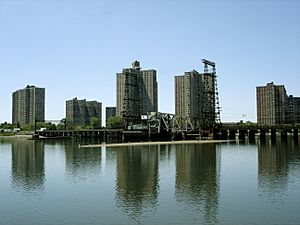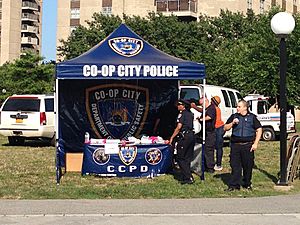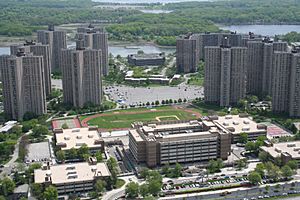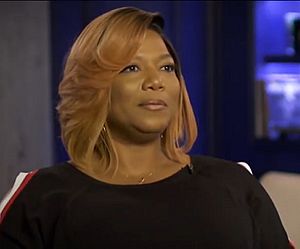Co-op City, Bronx facts for kids
Quick facts for kids
Co-op City
|
|
|---|---|
|
Neighborhood of the Bronx
|
|
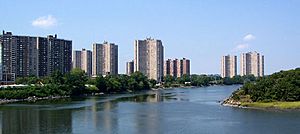
Co-op City, as seen from the east, sits along the Hutchinson River.
|
|
| Country | |
| State | |
| City | |
| Borough | |
| Community District | The Bronx 10 |
| Constructed | 1966-73 |
| Area | |
| • Total | 2.42 km2 (0.936 sq mi) |
| Population
(2010)
|
|
| • Total | 43,752 |
| • Density | 18,048/km2 (46,744/sq mi) |
| Race & Ethnicity | |
| • White | 7% |
| • Black | 59% |
| • Hispanic | 29% |
| • Asian | 2% |
| • Other | 1% |
| Economics | |
| • Median Household Income | ,951 |
| ZIP Code |
10475
|
| Area code(s) | 718, 347, 929, and 917 |
| Website | https://coopcity.com/ |
Co-op City (short for Cooperative City) is a huge cooperative housing community in the northeast part of the Bronx in New York City. It's bordered by Interstate 95 and the Hutchinson River Parkway. With over 43,000 people living there in 2010, it's the biggest housing cooperative in the world!
Before Co-op City was built, this area was marshland. From 1960 to 1964, it was home to an amusement park called Freedomland U.S.A.. Construction for Co-op City started in 1966. The first families moved in by 1968, and the whole project was finished in 1973. The United Housing Foundation helped build it, with money from the New York State Housing Finance Agency.
Co-op City is part of Bronx Community District 10. Its ZIP Code is 10475. Nearby fun places include Pelham Bay Park, Orchard Beach, and City Island.
Contents
What is Co-op City Like?
Co-op City has 15,372 homes. These are in 35 tall apartment buildings and seven groups of townhouses. This makes it the largest living area of its kind in the United States. It covers about 320 acres (1.3 km²). Only 20% of this land is built on, leaving lots of green spaces.
The apartment buildings are very tall, from 24 to 33 floors. There are different types of buildings:
- 10 "Triple Core" buildings (26 stories, 500 apartments each).
- 10 "Chevron" buildings (24 stories, 414 apartments each).
- 15 "Tower" buildings (33 stories, 384 apartments each).
- 236 townhouses (three stories high, with garden apartments and upper duplexes).
This "city within a city" has many useful things. It has eight parking garages and three shopping centers. There's also a 25-acre (10 ha) educational park. This park includes a high school, two middle schools, and three elementary schools. More than 40 offices are rented by doctors and other professionals. There are also 15 places of worship. You can find six nursery schools and day care centers, four basketball courts, and five baseball fields. The nearby Bay Plaza Shopping Center has a movie theater, department stores, and a supermarket.
Co-op City was built on land that used to be marshland. The ground around the buildings settles a little each year. This can cause small cracks in sidewalks and building entrances.
How Are Co-op City Streets Named?
Many streets in Co-op City are named after famous historical people. The streets are often grouped by section. For example, streets in section one usually start with "D".
Some examples of street names include:
- Adler Place – named for archaeologist Cyrus Adler.
- Alcott Place – named for author Louisa May Alcott.
- Einstein Loop – named for physicist Albert Einstein.
- Earhart Lane – named for aviator Amelia Earhart.
Other streets are named after local history:
- Bartow Avenue – named after Reverend John Bartow.
- Baychester Avenue – named after a real estate project from the 1890s.
- Hutchinson River Parkway – named for the Hutchinson River.
History of Co-op City
What Was Here Before Co-op City?

The land where Co-op City now stands was once a large swampy area. People used to call it "the dump." Much of the land was flat and used for recreation.
South of the Hutchinson River, there was more swampland. A water channel connected to the Hutchinson River. This area had boat yards and places to rent canoes in the 1950s.
A big part of the area became a theme park called Freedomland U.S.A.. This park was 205 acres (83 ha) and operated from 1960 to 1964. It closed because it went bankrupt. A small piece of the old park site is still zoned for large amusement parks today.
How Was Co-op City Developed?
In 1965, plans for Co-op City were announced. It was going to be the world's largest housing cooperative. Construction started in May 1966. Many parts of the old Freedomland site were filled in. Some existing houses near Givans Creek were kept, even though they were much lower than the new ground level. This caused some flooding issues at first.
People started moving into Co-op City in December 1968. The entire project was finished in 1973. The United Housing Foundation helped build and sponsor it. The architect was Herman J. Jessor. The company that runs the complex is now called RiverBay at Co-op City.
How Was Co-op City Paid For?
The building of Co-op City was paid for with a loan from the New York State Housing Finance Agency (HFA). In 1975, the complex had trouble paying back the loan.
There were problems with how the project was managed and built. This led to the loan default in 1975. The original board resigned, and the state took over. Residents faced a 25% increase in their monthly fees. They decided to stop paying their fees in protest. New York State threatened to take over the property. However, the residents stayed united for 13 months. This was the longest and largest strike of its kind in U.S. history.
Eventually, a deal was made. Residents paid back some of the money they owed. In return, they got to take over managing the complex themselves.
In 2004, Co-op City again had financial difficulties because of high repair costs. New York Community Bank helped RiverBay pay off its mortgage. By 2008, RiverBay had shown enough proof of repairs to clear its debt to New York State.
What Renovations Have Happened?
In the early 2000s, Co-op City started a big renovation project. It cost $240 million. They replaced pipes, garbage compactors, and fixed garages and roofs. They also updated the power plant and replaced all 130,000 windows and 4,000 terrace doors. All 179 elevators were also replaced.
Many of these changes helped make the complex more "green." The power plant became less polluting. Buildings became more energy-efficient. Recycling efforts also increased. The New York State Energy Research and Development Authority (NYSERDA) gave Co-op City a large grant of $5.2 million for these improvements.
In 2003, five of the eight parking garages were found to be unsafe. They had to be closed for major repairs. This caused a parking problem. New York City allowed angled parking, and some green areas were paved over for temporary parking lots. All garages were reopened by 2008.
The cost of these upgrades was a big debate between RiverBay and New York State. Co-op City was built under a program that helps with affordable housing. RiverBay argued the state should help pay because of problems from the original construction. The state said RiverBay was responsible for not keeping up with maintenance. They reached a compromise: the state gave some money, and RiverBay got a new mortgage of $480 million in 2004 to cover the rest.
In 2007, the power plant was upgraded. It can now produce its own energy using oil, gas, or steam. This project cost about $90 million. It is expected to save the community around $18 million each year. Any extra power generated can also be sold back to the electrical grid, bringing in more money for RiverBay.
How is Co-op City Managed?
RiverBay Corporation runs Co-op City. It is led by a 15-member board of directors. Since it's a cooperative, the residents manage the complex through this elected board. Board members are not paid. The corporation employs over 1,000 people. It has 32 departments to serve the community.
Co-op City has its own Public Safety Department. It has more than 100 officers. In 2007, more surveillance cameras were installed throughout the complex. These cameras are watched at the Public Safety Command Center. Officers also use bikes and Segways to patrol during warmer months.
Douglas Elliman Property Management currently manages the development. There are two weekly newspapers for the community: Co-op City Times and City News.
Who Lives in Co-op City?
In 2010, Co-op City had 43,752 residents. This was an increase of about 7.6% from 2000. The neighborhood covers about 857.55 acres (347.04 ha).
The people living in Co-op City come from many different backgrounds:
- About 8.5% are White.
- About 60.5% are African American.
- About 27.7% are Hispanic or Latino.
- About 1.2% are Asian.
The average life expectancy in this area is about 81.1 years. Most residents are young and middle-aged adults. About 20% are under 18, and 26% are between 25 and 44.
In 2017, the average household income in this area was $59,522. About 14% of residents live in poverty. This is lower than the average for the Bronx and New York City.
Co-op City has a large number of senior citizens. Over 8,300 residents are over sixty years old. This makes it the largest "naturally occurring retirement community" (NORC) in the country. It has programs to help its older residents.
In its early years, Co-op City had many Jewish, Italian, and Irish residents. Many moved from other parts of the Bronx. Over time, more African American and Hispanic residents moved in. After the fall of the Soviet Union in the 1990s, many people from Russia and Albania also moved to the neighborhood.
Co-op City Public Safety Department
The Co-op City Department of Public Safety is a private security force. It protects the residents, visitors, and property of Co-op City. It has over 100 Public Safety officers and 10 civilian employees.
Fire Safety
The New York City Fire Department (FDNY) helps keep Co-op City safe. Engine Co. 66/Ladder Co. 61 fire station is located at 21 Asch Loop.
Post Offices and ZIP Code
Co-op City uses the ZIP Code 10475. The United States Postal Service has three post offices in Co-op City:
- Co-op City Station – 3300 Conner Street
- Dreiser Loop Station – 179 Dreiser Loop
- Einstein Station – 127 Einstein Loop
Parks and Green Spaces
The biggest green area in Co-op City is the Greenway. It connects all the buildings. Much of Co-op City was built on top of Rattlesnake Creek, a small stream. There's also a small nature preserve called the Givans Creek Woods.
Co-op City Field is located by the Hutchinson River. It has two baseball fields. A new waterfront park is also being planned nearby.
Education in Co-op City
Compared to the rest of New York City, Community District 10 has fewer residents with college degrees. About 34% of adults aged 25 and older have a college education. However, students in Community District 10 are doing better in school. The percentage of elementary school students doing well in math rose from 29% in 2000 to 47% in 2011. Reading scores also improved.
About 21% of elementary school students miss 20 or more days of school each year. This is a little higher than the city average. However, 75% of high school students in Community District 10 graduate on time. This is the same as the citywide average.
Schools in Co-op City
The New York City Department of Education runs several public schools in Co-op City:
- PS 153 Helen Keller (grades PK–5)
- PS 160 Walt Disney (grades PK–5)
- PS 176 (grades PK–10)
- PS 178 Dr Selman Waksman (grades K–5)
- MS 180 Dr Daniel Hale Williams (grades 6–8)
- IS 181 Pablo Casals (grades 6–8)
- Harry S Truman High School (grades 9–12)
- Bronx Health Sciences High School (grades 9–12)
Library in Co-op City
The New York Public Library has a branch in Baychester, located at 2049 Asch Loop North. This library opened in 1973 and was updated in 2003.
Transportation in Co-op City
Co-op City is served by several MTA bus routes. These buses connect Co-op City to other parts of the Bronx and even to Manhattan and Queens.
Some bus routes include:
- Bx5: to Bay Plaza Shopping Center or Simpson Street station (2 5 trains)
- Bx12: to Bay Plaza Shopping Center or University Heights
- Bx23: to Pelham Bay Park station (6 <6> trains)
- BxM7: express bus to Midtown Manhattan
Currently, Co-op City does not have its own subway or Metro-North train station. However, there are plans to build a new Co-op City station for Metro-North trains as part of the Penn Station Access project. This idea has been discussed since the 1970s.
Famous People From Co-op City
Many notable people have lived in Co-op City, including:
- Brian Ash (born 1974), screenwriter and producer.
- Kurtis Blow (born 1959), a pioneer in old school hip hop music.
- Chris Canty (born 1982), a professional football player.
- Queen Latifah (born 1970), a famous actress and rapper.
- Sonia Sotomayor (born 1954), an Associate Justice of the United States Supreme Court.
- Rod Strickland (born 1966), a former NBA basketball player.


